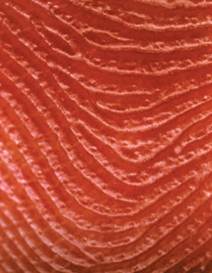


 النبات
النبات
 الحيوان
الحيوان
 الأحياء المجهرية
الأحياء المجهرية
 علم الأمراض
علم الأمراض
 التقانة الإحيائية
التقانة الإحيائية
 التقنية الحيوية المكروبية
التقنية الحيوية المكروبية
 التقنية الحياتية النانوية
التقنية الحياتية النانوية
 علم الأجنة
علم الأجنة
 الأحياء الجزيئي
الأحياء الجزيئي
 علم وظائف الأعضاء
علم وظائف الأعضاء
 الغدد
الغدد
 المضادات الحيوية
المضادات الحيوية|
Read More
Date: 16-10-2015
Date: 26-10-2015
Date: 22-10-2015
|
Touch
Touch is one of the five major sensory channels by which humans sample and experience their environment. The word “touch” describes the sensory experience resulting from gentle contact of the skin with the environment, including air moving over the skin and hairs. The sense of touch is so exquisitely sensitive that the brain can consciously experience the activity of a single neuron supplying the skin. Touch sensation not only informs one about the near environment but plays an essential role in guiding fine movements basic to such skills as playing musical instruments, reading Braille, typing on a computer keyboard, or performing surgery.

The fingertips are richly endowed with nerve endings and are very sensitive.
Touch (mechanoreception) is distinguished from pain (nociception) and temperature perception (thermoreception). Pain is sensed by free nerve endings, mostly located in the skin, bones, and joint capsules, and around blood vessels. Two broad categories of painful sensations, fast pricking pain versus slow aching or burning pain, are carried to the spine by two different types of sensory neurons. Thermoreceptors are located immediately below the skin, with warmth receptors more numerous than cool receptors. They are most sensitive not to absolute level of temperature, but to rapid change in temperature, and quickly become quieter once the temperature has stabilized at a new level.
Detection of touch stimuli begins with mechanical deformation of several types of specialized touch receptors, distributed unevenly over the body surface. Nerve fiber endings in the skin may be free, “naked” endings (for light touch) or more commonly are associated with other, cooperating cells. Thus nerve endings that wrap around hair follicles are activated by hair movement; other nerve endings adhere closely to specialized accessory cells or have tiny cellular capsules. The latter include pacinian corpuscles for vibration, and Meissner corpuscles (abundant in sensitive, hairless skin of the fingertips) for light touch. Ruffini corpuscles and Merkel disks respond to pressure or to stretch of the skin with signals that continue as long as a stimulus is applied.
When any of these touch-sensitive nerve endings are mechanically deformed, electrical signals (action potentials) are transmitted along the axons of sensory nerve cells. These signals pass rapidly to the spinal cord and brainstem to activate a second set of neurons. As these secondary touch cells relay information up the brainstem, their axons cross the body’s midline, so that the touch information they carry activates neurons in the thalamus on the side opposite the stimulation. Thalamic neurons transmit the signal to the primary sensory cortex in the brain’s postcentral gyrus, where touch is actually experienced.
All of the touch information transmitted from the various receptor types in a given body area is combined in the cerebral cortex. It provides sophisticated analysis of the total pattern of nerve signals so that one can instantly (and consciously) judge the texture, force, location, and movement of the skin stimulus with great precision.
Touch sensitivity varies in different body regions because of differential density of distribution of the specific nerve endings. Areas such as the fingertips and lips (glabrous skin) are richly endowed with nerve endings and are very sensitive. Hairy skin has fewer endings and different kinds, and so produces a different sensory experience; skin of the trunk and back, with a low density of touch receptors, is less sensitive to touch than skin elsewhere.
Touch receptors branch out at their ends, and a single neuron may receive input from a region of the skin several centimeters in diameter, called its receptor field. Receptor fields in the lips may be as small as 2 to 3 millimeters (.78 to .118 inches), while in much of the rest of the body they are 4 to 7 centimeters (1.5 to 2.7 inches).
References
Delcomyn, Fred. Foundations of Neurobiology. New York: W. H. Freeman and Company, 1998.
Kandel, Eric. R., James H. Schwartz, and Thomas M. Jessell, eds. Essentials of Neural Science and Behavior. Norwalk, CT: Appleton and Lange, 1995.



|
|
|
|
صنع الذكريات والتفكير يدمر الدماغ.. دراسة تشرح السبب
|
|
|
|
|
|
|
بركان ينفت الذهب في أقصى جنوب الأرض.. ما القصة؟
|
|
|
|
|
|
السيد الصافي يزور قسم التربية والتعليم ويؤكد على دعم العملية التربوية للارتقاء بها
|
|
|
|
لمنتسبي العتبة العباسية قسم التطوير ينظم ورشة عن مهارات الاتصال والتواصل الفعال
|
|
|
|
في جامعة بغداد.. المؤتمر الحسيني الثاني عشر يشهد جلسات بحثية وحوارية
|
|
|
|
للأطفال نصيبهم من جناح جمعية العميد في معرض تونس الدولي للكتاب.. عمّ يبحثون؟
|